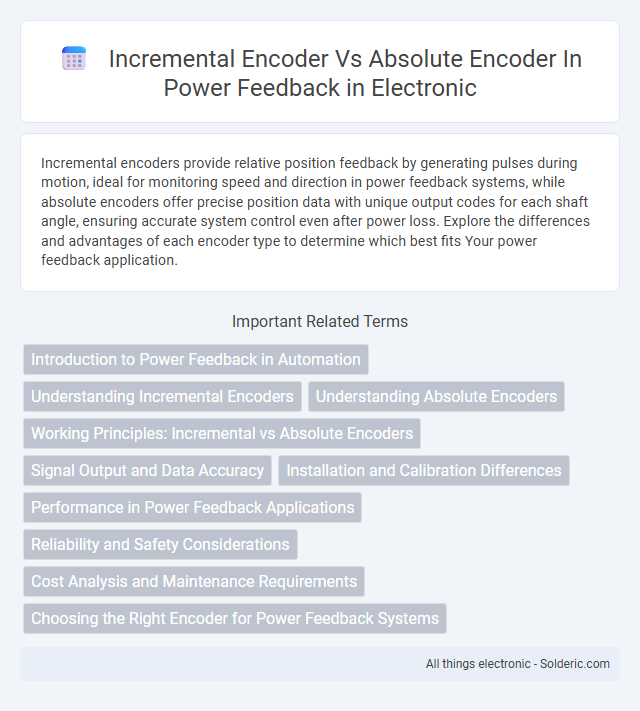Incremental encoders provide relative position feedback by generating pulses during motion, ideal for monitoring speed and direction in power feedback systems, while absolute encoders offer precise position data with unique output codes for each shaft angle, ensuring accurate system control even after power loss. Explore the differences and advantages of each encoder type to determine which best fits Your power feedback application.
Comparison Table
| Feature | Incremental Encoder | Absolute Encoder |
|---|---|---|
| Position Feedback | Relative position, tracks movement from a reference point | Absolute position, provides unique position value at all times |
| Power Feedback Use | Requires homing or reference at startup for accurate feedback | Instant accurate position; no homing needed at startup |
| Signal Type | Pulses (quadrature signals) | Digital code (binary, gray code) |
| Accuracy | High resolution but cumulative error possible | High precision, error-free position on power loss |
| Complexity & Cost | Simple design, cost-effective | Complex design, higher cost |
| Power Loss Impact | Position lost, requires re-homing | Position retained without loss |
Introduction to Power Feedback in Automation
Power feedback in automation is essential for precise motor control, relying on encoders to monitor shaft position and speed. Incremental encoders generate pulses corresponding to movement increments, requiring a reference point to determine absolute position. Absolute encoders provide unique position values at every shaft angle, ensuring accurate power feedback even after power loss or system resets.
Understanding Incremental Encoders
Incremental encoders generate pulse signals proportional to the shaft's rotational movement, enabling precise measurement of position changes and speed in power feedback systems. These devices rely on relative position tracking by counting pulses from a reference point, which requires an initial homing sequence at startup to establish a zero position. The simplicity and high resolution of incremental encoders make them ideal for applications demanding accurate velocity control and incremental position feedback.
Understanding Absolute Encoders
Absolute encoders provide precise position feedback by outputting a unique code for each shaft position, ensuring accurate and reliable data even after power loss. Their ability to retain exact position information without needing a reference point makes them essential for applications requiring high accuracy and consistent power feedback. Unlike incremental encoders, absolute encoders eliminate the need for homing sequences at startup, enhancing efficiency in industrial automation and robotics.
Working Principles: Incremental vs Absolute Encoders
Incremental encoders generate pulse signals by detecting shaft rotation through a series of equally spaced lines, providing relative position changes that require a reference point for accurate tracking. Absolute encoders use unique binary or Gray code patterns on encoder discs to provide a distinct position value for every shaft angle, allowing immediate position identification without needing reference resets. Your choice between incremental and absolute encoders depends on whether real-time absolute position feedback or relative movement tracking is critical for your power feedback system.
Signal Output and Data Accuracy
Incremental encoders generate pulse signals that provide relative position data, making them ideal for applications requiring speed and direction monitoring but demanding external reference for accurate positioning. Absolute encoders output unique digital codes corresponding to each shaft position, ensuring precise and unambiguous data retention even after power loss. Signal output from absolute encoders delivers higher data accuracy and reliability in power feedback systems compared to the incremental type, which relies on cumulative pulse counting.
Installation and Calibration Differences
Incremental encoders require precise alignment during installation to establish a reference point, often necessitating a separate homing procedure for calibration each time the system powers up. Absolute encoders provide unique position values immediately upon startup, eliminating the need for homing and simplifying installation processes. Your choice impacts setup time and accuracy, especially in applications demanding immediate position feedback after power loss.
Performance in Power Feedback Applications
Incremental encoders provide high-resolution position changes and rapid feedback ideal for dynamic power feedback applications requiring precise speed control. Absolute encoders deliver unique position values, ensuring accurate and reliable feedback even during power loss or startup, critical for applications demanding exact position information. Your choice depends on whether continuous position tracking or precise speed monitoring is essential for optimal power feedback performance.
Reliability and Safety Considerations
Incremental encoders offer high-resolution feedback and are cost-effective but require a reference point for position accuracy, which can pose reliability risks if power loss occurs. Absolute encoders provide unique position values at all times, enhancing safety by maintaining accurate position data even during power interruptions, making them ideal for critical power feedback systems. Your choice between the two should prioritize system safety requirements and the need for continuous, dependable position feedback.
Cost Analysis and Maintenance Requirements
Incremental encoders typically offer lower upfront costs and simpler maintenance due to their straightforward design and fewer electronic components, making them ideal for budget-sensitive applications. Absolute encoders, while more expensive initially, reduce ongoing maintenance expenses by providing precise position feedback without the need for homing sequences after power interruptions, enhancing reliability in complex systems. The choice between incremental and absolute encoders should weigh initial investment against long-term operational efficiency and maintenance demands in power feedback applications.
Choosing the Right Encoder for Power Feedback Systems
Selecting the appropriate encoder for power feedback systems depends on accuracy, reliability, and application requirements. Incremental encoders offer high resolution and cost-effective position tracking but require a reference point for absolute position. Absolute encoders provide precise, unique position data at startup, enhancing system reliability and reducing downtime, making them ideal for critical power feedback applications where continuous monitoring is essential for Your system's performance.
Incremental Encoder vs Absolute Encoder in Power Feedback Infographic

 solderic.com
solderic.com